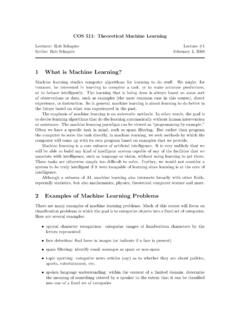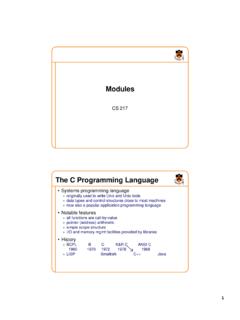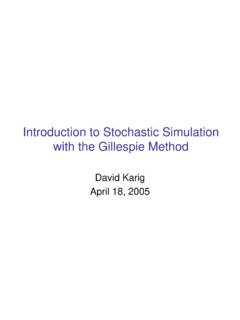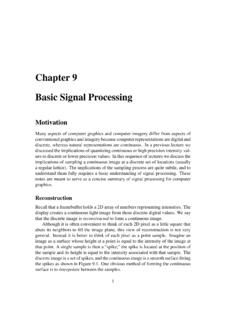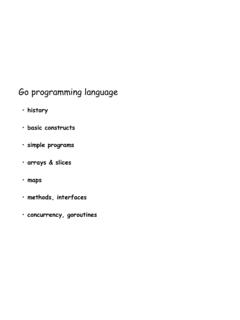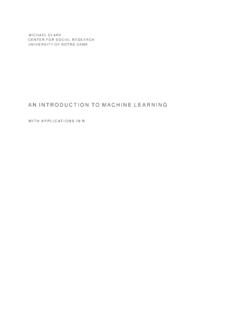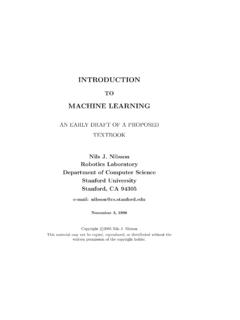Transcription of An Introduction to MCMC for Machine Learning
1 Machine Learning , 50, 5 43, 2003c 2003 Kluwer Academic Publishers. Manufactured in The Introduction to mcmc for Machine LearningCHRISTOPHE of Mathematics, Statistics Group, University of Bristol, University Walk, Bristol BS8 1TW, UKNANDO DE of Computer Science, University of British Columbia, 2366 Main Mall, Vancouver,BC V6T 1Z4, CanadaARNAUD of Electrical and Electronic Engineering, University of Melbourne, Parkville, Victoria 3052, AustraliaMICHAEL I. of Computer Science and Statistics, University of California at Berkeley, 387 Soda Hall, Berkeley,CA 94720-1776, purpose of this introductory paper is threefold. First, it introduces the Monte Carlo method withemphasis on probabilistic Machine Learning .
2 Second, it reviews the main building blocks of modern Markov chainMonte Carlo simulation, thereby providing and Introduction to the remaining papers of this special issue. Lastly,it discusses new interesting research :Markov chain Monte Carlo, mcmc , sampling, stochastic algorithms1. IntroductionA recent survey places the Metropolis algorithm among the ten algorithms that have had thegreatest influence on the development and practice of science and engineering in the 20thcentury (Beichl & Sullivan, 2000). This algorithm is an instance of a large class of samplingalgorithms, known as Markov chain Monte Carlo ( mcmc ). These algorithms have playeda significant role in statistics, econometrics, physics and computing science over the lasttwo decades.
3 There are several high-dimensional problems, such as computing the volumeof a convex body inddimensions, for which mcmc simulation is the only known generalapproach for providing a solution within a reasonable time (polynomial ind) (Dyer, Frieze,& Kannan, 1991; Jerrum & Sinclair, 1996).While convalescing from an illness in 1946, Stan Ulam was playing solitaire. It, then,occurred to him to try to compute the chances that a particular solitaire laid out with 52 cardswould come out successfully (Eckhard, 1987). After attempting exhaustive combinatorialcalculations, he decided to go for the more practical approach of laying out several solitairesat random and then observing and counting the number of successful plays.
4 This idea ofselecting a statistical sample to approximate a hard combinatorial problem by a muchsimpler problem is at the heart of modern Monte Carlo ANDRIEU ET Ulam soon realised that computers could be used in this fashion to answer ques-tions of neutron diffusion and mathematical physics. He contacted John Von Neumann,who understood the great potential of this idea. Over the next few years, Ulam and VonNeumann developed many Monte Carlo algorithms, including importance sampling andrejection sampling. Enrico Fermi in the 1930 s also used Monte Carlo in the calculation ofneutron diffusion, and later designed the FERMIAC, a Monte Carlo mechanical device thatperformed calculations (Anderson, 1986).
5 In the 1940 s Nick Metropolis, a young physicist,designed new controls for the state-of-the-art computer (ENIAC) with Klari Von Neumann,John s wife. He was fascinated with Monte Carlo methods and this new computing he designed an improved computer, which he named the MANIAC in the hope thatcomputer scientists would stop using acronyms. During the time he spent working on thecomputing machines, many mathematicians and physicists (Fermi, Von Neumann, Ulam,Teller, Richtmyer, Bethe, Feynman, & Gamow) would go to him with their work in 1949, he published thefirst public document on Monte Carlo simulation withStan Ulam (Metropolis & Ulam, 1949).
6 This paper introduces, among other ideas, MonteCarlo particle methods, which form the basis of modern sequential Monte Carlo methodssuch as bootstrapfilters, condensation, and survival of thefittest algorithms (Doucet, deFreitas, & Gordon, 2001). Soon after, he proposed the Metropolis algorithm with the Tellersand the Rosenbluths (Metropolis et al., 1953).Many papers on Monte Carlo simulation appeared in the physics literature after an inference perspective, the most significant contribution was the generalisation ofthe Metropolis algorithm by Hastings in 1970. Hastings and his student Peskun showed thatMetropolis and the more general Metropolis-Hastings algorithms are particular instancesof a large family of algorithms, which also includes the Boltzmann algorithm (Hastings,1970; Peskun, 1973).
7 They studied the optimality of these algorithms and introduced theformulation of the Metropolis-Hastings algorithm that we adopt in this paper. In the 1980 s,two important mcmc papers appeared in thefields of computer vision and artificial in-telligence (Geman & Geman, 1984; Pearl, 1987). Despite the existence of a few mcmc publications in the statistics literature at this time, it is generally accepted that it was only in1990 that mcmc made thefirst significant impact in statistics (Gelfand & Smith, 1990). Inthe neural networks literature, the publication of Neal (1996) was particularly the Introduction to this special issue, we focus on describing algorithms that we feelare the main building blocks in modern mcmc programs.
8 We should emphasize that inorder to obtain the best results out of this class of algorithms, it is important that we do nottreat them as black boxes, but instead try to incorporate as much domain specific knowledgeas possible into their design. mcmc algorithms typically require the design of proposalmechanisms to generate candidate hypotheses. Many existing Machine Learning algorithmscan be adapted to become proposal mechanisms (de Freitas et al., 2001). This is oftenessential to obtain mcmc algorithms that converge quickly. In addition to this, we believethat the Machine Learning community can contribute significantly to the solution of manyopen problems in the mcmc field.
9 For this purpose, we have outlined several hot researchdirections at the end of this paper. Finally, readers are encouraged to consult the excellenttexts of Chen, Shao, and Ibrahim (2001), Gilks, Richardson, and Spiegelhalter (1996), Liu(2001), Meyn and Tweedie (1993), Robert and Casella (1999) and review papers by BesagINTRODUCTION7et al. (1995), Brooks (1998), Diaconis and Saloff-Coste (1998), Jerrum and Sinclair (1996),Neal (1993), and Tierney (1994) for more information on remainder of this paper is organised as follows. In Part 2, we outline the generalproblems and introduce simple Monte Carlo simulation, rejection sampling and importancesampling.
10 Part 3 deals with the Introduction of mcmc and the presentation of the mostpopular mcmc algorithms. In Part 4, we describe some important research frontiers. Tomake the paper more accessible, we make no notational distinction between distributionsand densities until the section on reversible jump mcmc motivationMCMC techniques are often applied to solve integration and optimisation problems inlarge dimensional spaces. These two types of problem play a fundamental role in machinelearning, physics, statistics, econometrics and decision analysis. The following are just inference and Learning . Given some unknown variablesx Xand datay Y,the following typically intractable integration problems are central to Bayesian statistics(a)Normalisation.
